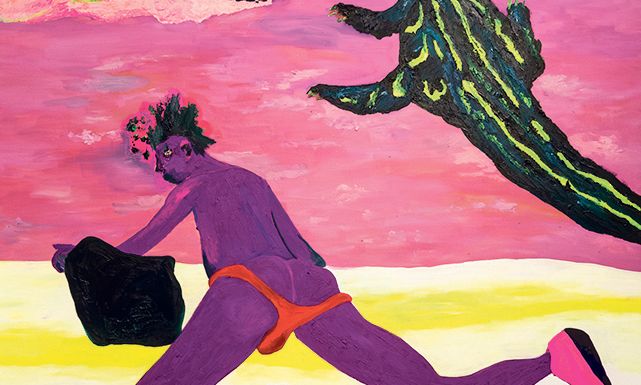Florian Krewer, winding (2023) © Liliana Mora
The New York-based artist Florian Krewer uses animal motifs to “convey emotions he could not physically put into people”, says Michael Werner Gallery’s Birte Kleemann. His work can be bright, bold and colourful—as is the case here—but he sees painting as a serious exercise. In this piece, Kleeman notices “a certain vulnerability”, a feeling The Art Newspaper would share if it, too, were lying on a beach beside a huge, carnivorous reptile.
Radamés “Juni” Figueroa, La Guarida del Caimán #2 (Vega Baja) (2023) © Liliana Mora
This work is part of a series in which Figueroa zones in on caimans. These alligatorids—depicted playing pool, sitting in laps or lying on inflatables—were introduced to Figueroa’s homeland of Puerto Rico in the 1960s and have since proliferated. Figueroa uses a “humoristic lens”, says the gallery’s Enrique Morales Larraondo, to ask serious questions about colonisation and “who gets to enjoy the tropics”.
Henrik Olesen, Crocodile (2023) © Liliana Mora
Henrik Olesen bundles references ranging from a work by David Wojnarowicz to the crocodile in Peter Pan into this intimidating sculpture. “It’s supposed to look almost like a fossil,” says Galerie Buchholz’s Filippo Weck. (This was a relief to hear, as it looked pretty alive from where we were standing.) Made from materials such as plaster, acrylic and wood, it can be snapped up for a tasty $60,000.
Chico da Silva (Francisco Domingos da Silva), Animais fantásticos (fantastic animals, 1964) © Liliana Mora
The alligator-like creature in this painting is not, in fact, what it appears to be at first sight. “These animals don’t really exist,” says Luyza De Luca, the gallery’s head of sales. They are, instead, examples of imagined creatures commonplace in the work of the self-taught artist Chico da Silva—who was born in northern Brazil and died in 1985—and in some ways inspired by animals found in the Amazon rainforest and elsewhere. “You can’t have an alligator with these kinds of legs,” De Luca says, showing up this reporter’s scientific shortcomings.
Cate Giordano, Parts of the Brain (2023) © Liliana Mora
Part of a multimedia installation by the New York-based artist and filmmaker Cate Giordano, this pale-faced croc is an example of how Giordano “delves into the psychological interpretation of animal and mythological figures as representations of human behaviour and the ways in which these motifs define our understanding of life and what comes after”, according to a gallery statement. Light stuff, then. The installation is available for a relative bargain, too: $12,000.

